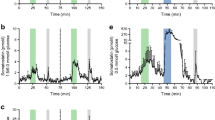Abstract
Glucagon-like peptide-1 binding sites have been reported in peripheral tissues including muscle. However, the potential extra-pancreatic effects of glucagon-like peptide-1(7-36)amide are controversial. To evaluate whether glucagon-like peptide-1(7-36)amide has any effects on skeletal muscle glucose transport, isolated rat soleus muscles were incubated in increasing concentrations of insulin (0–150 nmol/l) in the presence or absence of 1 nmol/l glucagon-like peptide-1(7-36)amide for 3 h. Subsequently glucose transport was measured as uptake of [3H]-O-methylglucose. It was found that glucagon-like peptide-(7-36)amide has a small but significant stimulating effect on skeletal muscle glucose transport independent of the insulin concentration (P<0.01). However, because of the magnitude of the observed effect, the physiological importance of glucagon-like peptide-1 (7-36)amide on skeletal muscle glucose metabolism is questionable.
Similar content being viewed by others
Author information
Authors and Affiliations
Additional information
Received: 27 February 1998 / Accepted in revised form: 30 April 1998
Rights and permissions
About this article
Cite this article
Hansen, B., Jensen, P., Nepper-Christensen, E. et al. Effects of glucagon-like peptide-1 (7-36)amide on insulin stimulated rat skeletal muscle glucose transport. Acta Diabetologica 35, 101–103 (1998). https://doi.org/10.1007/s005920050112
Issue Date:
DOI: https://doi.org/10.1007/s005920050112




